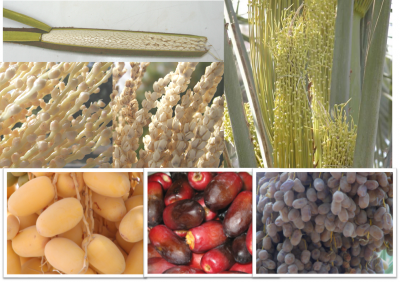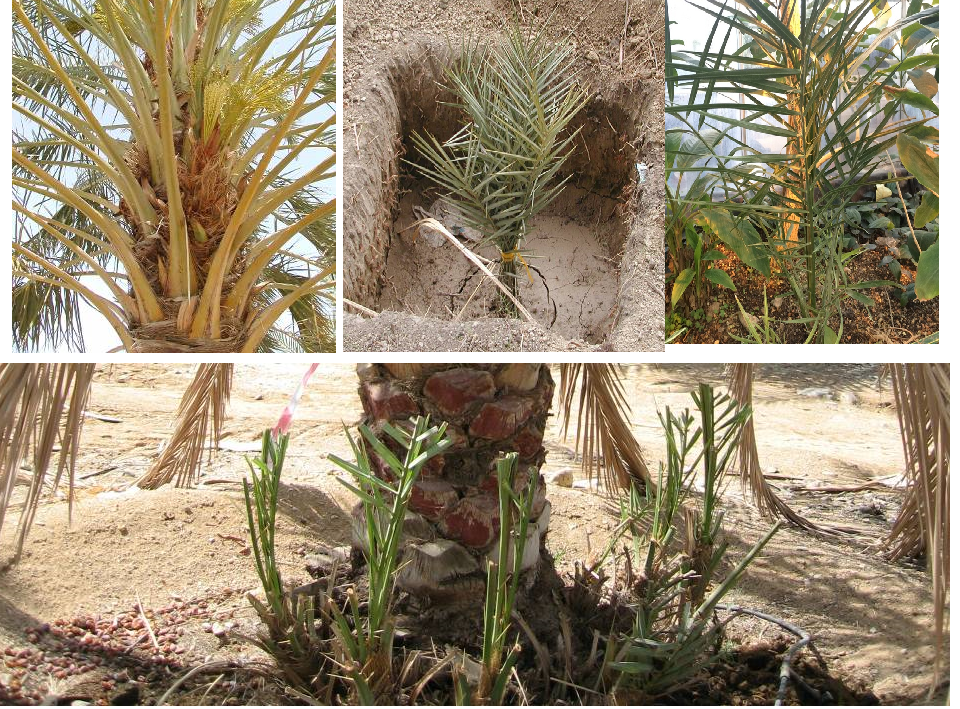
Traditional date palm farm in Oman (R Al-Yahyai)
The Date palm (Phoenix dactylifera L.) is grown throughout the arid and semiarid regions of the world, particularly in West Asia and North Africa. It is well adapted to the desert environment, where a dry and warm climate is important for fruit maturity and ripening.
Although date palms are mostly cultivated in arid regions; they can also be grown in many other countries such as the Americas, southern Europe, Asia, Africa, and Australia for food or as an ornamental plant. In addition to decoration, date palms play a vital role as food, and can be readily managed as a subsistence crop in many developing and under-developed countries, because dates have high nutritional value, particularly high calories and mineral contents and are readily stored (Al-Yahyai & Manickavasagan 2012).

Date palm distribution in the world (FAO 2014)
Religious Significance of the Date Palm
The date palm has been planted since 2400 BC and it was praised in many ancient civilizations such as the Sumerians, Assyrians, Babylonians, and Egyptians as is evidenced from their drawings and sculptures. Moreover, the date palm is still considered as sacred tree among all three major religions of the world. In Islam, for instance you find the holy Quran cited date palms 21 times and the Hadith of the Prophet Mohammed cited it 300 times, making it the highest cited plant. Furthermore, the date palm is praised in Christian and Judaism faiths and is common in many religious celebrations such as Passover and Palm Sunday.
Botanical Classification

An image of a camel from folded date palm pinnules is one of the more unusual specimens in RNG herbarium.
The date palm, Phoenix dactylifera L., is an angiosperm, a monocotyledonous plant that belongs to the family Arecaceae. This family has 200 genera, of which Phoenix contains 12 of the 1500 species. Date palm is characterized by pinnated leaves and conduplicate leaflets with acute tips (Uhl and Dransfield 1987). There are two other common cultivated Phoenix palms, canary P. canariensis and sugar palm, P. sylvestris (Zaid and de Wet 2002).
Date palm is a dioecious plant, that is female and male flowers are born on two separate palms. Pollination involves manually inserting the male strands into the female inflorescence (spadix). In order to have high quality yield of date palm, it is extremely important to select suitable male palm for pollination due to the metaxenic effect of date palm pollen on fruit quality & maturity (Swingle 1928). There are thousands of male and female cultivars distributed throughout date palm-growing countries. For example, in the Sultanate of Oman, there are over 200 female and 21 male cultivars (Al-Yahyai 2008).

Flowering and fruiting characteristics of date palm (R Al-Yahyai)
What is special about date palm?
There are several special botanical features that make the date palm unique among fruit trees. Phoenix height can exceed 20 m and trees survive over a hundred years. Leaves (fronds) of date palm remain intact to act as heat insulators, so under cultivation old leaves have to be removed manually. Date palms can survive under harsh conditions such as extended drought, high salinity levels and heat (Al-Yahyai & Manickavasagan 2012).

Date palm offshoots are born at the palm base. Newly planted offshoot upper-middle. Date palm offshoot at University of Reading Tropical Greenhouse (R Al-Yahyai and T Al-Jabri)
Date palm in Oman
Date palm is the most important crop in Oman, as it is the main fruit crop in the country. Almost 49% of cultivation areas in Oman are occupied by date palms and represent 82% of all fruit crops (Al Yahyai 2007). Approximately, there are over seven million date palms in Oman; the northern coastal areas of Oman have the majority of date palm plantations (Al Yahyai 2007). According to FAO data, Oman was the eighth’s largest world producer of dates in 2012 with a production of 270,000 MT (FAO, 2014). Numerous varieties exceeding 250 of date palm are cultivated throughout Oman and many more in other countries, such as Saudi Arabia which has over 400 cultivars. The most popular in Oman are Khalas, Khunaizi, Naghal, Khasab, Fardh, and Mabsli. Date farmers usually grow more than one cultivar to provide them with food and animal feed throughout the year. For example, the cultivar Naghal ripens early in the summer, Khunaizi ripens mid-season and Fardh is among the last to ripen toward the end of the harvest season in late autumn. Fruits of Khunaizi and Khalas are consumed fresh, while Fardh is left on the tree until the fruit dry then harvested and packed for consumption during the winter months. Because of its storability, Fardh is the common commercial cultivar used by industrial factories for export and processing (Al-Yahyai 2007).
The many uses of date palm in the past
In the past Omani people found innovative ways to use every part of the palm tree for shelter, furniture, animal fodder, food storage containers and numerous other items around their household such as baskets and ropes. Nothing from the date palm is thrown out and every part has a purpose.
Delicious honey in the trunk and from the fruit
Many people use date palm trunks to keep their bee hives that produce the most prized honey in Oman. Bees feed on wild flowers mainly in two flowering seasons, referred to as Ziziphus honey and Acacia honey, depending on the source of nectar.
The video below explains the process of keeping hives in palm trunks in Oman.
Boiled dates, Tabseel
Besides its use as fresh rutab or dry dates (tamar), fruits from date palm cultivar called Mabsli is boiled in a process known as tabseel, which is the boiling dates while at khalal stage (before they soften as rutab). The boiled dates are consumed locally and exported to markets in South Asia where this type of processed dates is preferred (Al-Yahyai 2008).
New era and new uses for the magical date palm
Recently a Omani young man come up with an idea on making paper out of date palm leaves. Read more about this interesting story.
In Oman, a research team discovered that waste date palm leaves are carbonised by sulphuric acid treatment at 170 degrees Celsius. ”They found that dehydrated carbon produced from date palm leaves is as efficient as activated carbon for removing pharmaceuticals and dyes from wastewater.” (Rehab Abd Almohsen 2012)
Another discovery in Oman is from the Oman Green Energy Company, they have been successful in producing and testing ethanol from date palm. Owner Al Harthy’s experiment was on running his own car on biofuel, he said: “All small cars can run on biofuel without any problems and it is much cheaper compared to conventional petrol and also helpful for our environment.”(Biopact team 2007)
Summary
This was a short overview of the many benefit of Date Palm, the most sacred plant on earth. Date palm can provide anything from food to biofuel. It is also suitable for cultivation in areas with extreme climate such as high heat, high salinity and low precipitation. Date palm is a special tree to many around the world and there is still a lot to be known about this unique plant.
References:
1. Al-Yahyai, R. and A . Manickavasagan. 2012. An overview of date palm production. In: A. Manickavasagan , M . Essa , and E . Sukumar (eds). Dates: Production, Processing, Food, and Medicinal Values. CRC Press, UK. Pp. 3–12
2. Al-Yahyai, Rashid. 2007. Improvement of date palm production in the Sultanate of Oman. Acta Horticulturae 736, 337-343
3. Al-Yahyai, Rashid. 2008. Date Palm Tradition of Oman. Horizon , Sultan Qaboos University.
4. Biopact team 2007. Oman Green Energy Company makes ethanol from date palm, plans large refinery, 100 ethanol pumps by 2010 . URL:http://news.mongabay.com/bioenergy/2007/06/oman-green-energy-company-makes-ethanol.html.
5. FAO. 2014. Food & Agriculture Organization of the United Nation. (http://www.faostat.fao.org). (Accessed: 23 Nov. 2014).
8. Uhl, N. W. and J. Dransfield. 1987. Genera Palmarum: A Classification of Palms Based on the Work of Harold E. Moore, Jr, L.H. Baily Hortorium and the International Palm Society, Lawrence, KS, pp. 214–217.
9. Zaid, A. and P. F. de Wet. 2002. Botanical and systematic description of the date palm. In: A. Zaid and E. J. Arias-Jiménez (eds.), Date Palm Cultivation. FAO Plant Production and Protection Paper 156 Rev. 1. Rome, Italy.

Pingback: 2014 Advent Botany – Day 21 – Dates (Phoenix dactylifera) | Culham Research Group